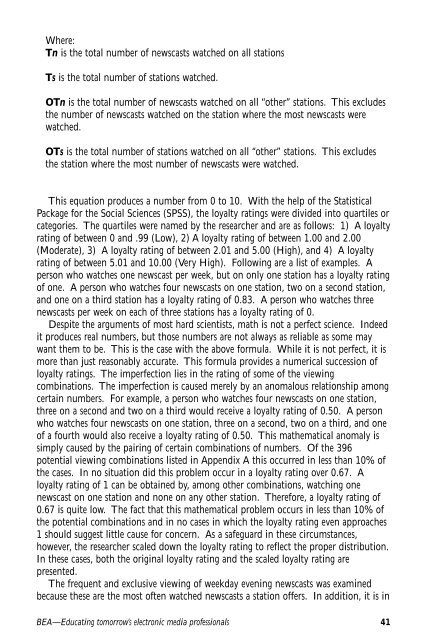APRILFeedback
Feedback April 2003 (Vol. 44, No. 2) - Broadcast Education ...
Feedback April 2003 (Vol. 44, No. 2) - Broadcast Education ...
- No tags were found...
You also want an ePaper? Increase the reach of your titles
YUMPU automatically turns print PDFs into web optimized ePapers that Google loves.
Where:Tn is the total number of newscasts watched on all stationsTs is the total number of stations watched.OTn is the total number of newscasts watched on all “other” stations. This excludesthe number of newscasts watched on the station where the most newscasts werewatched.OTs is the total number of stations watched on all “other” stations. This excludesthe station where the most number of newscasts were watched.This equation produces a number from 0 to 10. With the help of the StatisticalPackage for the Social Sciences (SPSS), the loyalty ratings were divided into quartiles orcategories. The quartiles were named by the researcher and are as follows: 1) A loyaltyrating of between 0 and .99 (Low), 2) A loyalty rating of between 1.00 and 2.00(Moderate), 3) A loyalty rating of between 2.01 and 5.00 (High), and 4) A loyaltyrating of between 5.01 and 10.00 (Very High). Following are a list of examples. Aperson who watches one newscast per week, but on only one station has a loyalty ratingof one. A person who watches four newscasts on one station, two on a second station,and one on a third station has a loyalty rating of 0.83. A person who watches threenewscasts per week on each of three stations has a loyalty rating of 0.Despite the arguments of most hard scientists, math is not a perfect science. Indeedit produces real numbers, but those numbers are not always as reliable as some maywant them to be. This is the case with the above formula. While it is not perfect, it ismore than just reasonably accurate. This formula provides a numerical succession ofloyalty ratings. The imperfection lies in the rating of some of the viewingcombinations. The imperfection is caused merely by an anomalous relationship amongcertain numbers. For example, a person who watches four newscasts on one station,three on a second and two on a third would receive a loyalty rating of 0.50. A personwho watches four newscasts on one station, three on a second, two on a third, and oneof a fourth would also receive a loyalty rating of 0.50. This mathematical anomaly issimply caused by the pairing of certain combinations of numbers. Of the 396potential viewing combinations listed in Appendix A this occurred in less than 10% ofthe cases. In no situation did this problem occur in a loyalty rating over 0.67. Aloyalty rating of 1 can be obtained by, among other combinations, watching onenewscast on one station and none on any other station. Therefore, a loyalty rating of0.67 is quite low. The fact that this mathematical problem occurs in less than 10% ofthe potential combinations and in no cases in which the loyalty rating even approaches1 should suggest little cause for concern. As a safeguard in these circumstances,however, the researcher scaled down the loyalty rating to reflect the proper distribution.In these cases, both the original loyalty rating and the scaled loyalty rating arepresented.The frequent and exclusive viewing of weekday evening newscasts was examinedbecause these are the most often watched newscasts a station offers. In addition, it is inBEA—Educating tomorrow’s electronic media professionals 41
















